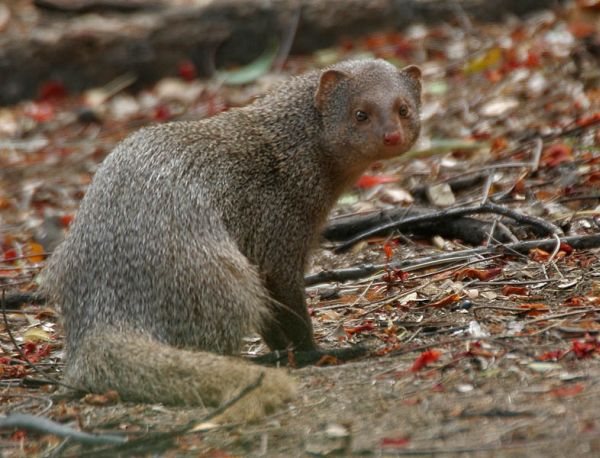The mongoose is a member of the family Herpestidae. They live primarily in Southern Asia, Africa, and southern Europe, as well as some Caribbean and Hawaiian islands. Some species have been found in parts of South America, including in Guyana.

Mongoose (Photo: WikiMedia Commons)
A mongoose is a sleek,
fast mammal that’s famous for being a brave snake hunter. Mongooses have sharp claws, quick reactions, and they are resistant to snake venom. They have been known to fight venomous snakes, like cobras, and win.
Their claws do not retract, and in most species there are five toes on each foot. Their fur is gray to brown and is commonly grizzled or flecked with lighter gray.
The largest mongoose is the white-tailed mongoose (Ichneumia albicauda), whose body length measures 48–71 cm (about 19–28 inches) long with a tail that may extend up to an additional 47 cm (18.5 inches).
The mongoose emits a high pitched noise, commonly known as giggling, when it mates. The giggling is also a form of courtship when this animal is choosing a mate.
Their Habitat
Mongooses live in burrows and feed on small mammals, birds, reptiles, eggs, and occasionally fruit. Some species of mongoose are very social and live in large groups called colonies. Colonies can have as many as 50 members. Other species of mongoose like to live alone.
They are active during the day and sleep at night. Throughout the day, they chatter incessantly to each other, and combine discrete units of sound somewhat like human speech, using vowel and syllable combinations to possibly coordinate group movements, foraging information and other important messages.
Offspring
Mongooses have gestation periods of 42 to 105 days and give birth to one to four offspring at a time.
Baby mongooses are called pups and a group of offspring is called a litter. It is believed that mongooses become fully mature between 9 months to 2 years of age and live from 6 to 10 years in the wild.
Some Interesting Facts About Mongoose
- Some mongooses are legendary snake fighters. The Indian gray mongoose is particularly known for its fondness of fighting and eating poisonous snakes, such as cobras.
- Mongooses can live for up to 20 years in captivity, according to National Geographic.
- Indian mongooses groom each other.
- Tuberculosis, a human disease, has been found in mongooses.
- Mummified mongooses have been discovered in ancient Egyptian tombs.
- The mongoose was introduced to Hawaii to kill rats
- These animals have very short limbs. They walk on their toes and hence, known as digitigrade.
- They belong to the same family as civets. They appear like weasels but are not related to them at all. They are omnivorous animals.
- Mongooses have developed special ability. We all know that brains have neurotransmitters. Mongooses are no different. They have a particular neurotransmitter known as acetylcholine, the receptor of which has mutated in such a way that mongooses have became partially immune to snake venom.
- When a snake bites a mongoose (even a cobra), the venom fails to bind to the receptors of acetylcholine. This means that muscles-nerve communication is not blocked and the venom bounces off the cells of the muscles.
- Mongooses will happily eat snakes as dinner or lunch and they actually tend to eat the whole snake including its venom sack.
- When the snake venom is digested, it causes no harm to the mongoose. That’s because, the venom of a snake needs to be injected into the body of the victim to become lethal. The neutralized snake cannot do that and hence, its venom just becomes the gravy of the meaty meal for mongoose.
- The mongooses proved to be a threat for the endogenous species of animals like birds. However, the irony is that these mongooses are threatened in their own natural habitat because of habitat loss.
- They are social animals which live in packs. The numbers in a pack varies from species to species. In general, it is around 6-40 mongooses in a pack. In some species, the pack usually has an alpha male and an alpha female. They lead the pack and this couple is the only couple which can copulate to produce more mongooses.
- The pack or mob or gang works as a family. Some hunt, some take care of young ones and any one of the member stands as a guard. This guard whistles or cries to inform other mongooses of any danger. Then they take shelter in their burrows till everything gets normal again.
- The mongooses which go for hunting bring back their prey and share it freely with other members.
- In some species, the mongooses don’t form any group or pack. They meet only once a year during the mating season. The male may stay and help the female to raise the pups or sometimes it is only female who takes care of her kids.
- In other species, the young ones ask for food from only one mongoose which is called as an escort. This escort should feed the kids till they get independent.
Watch This: Cobra Vs. Mongoose
About Mongoose
Mongooses have long faces and bodies, small rounded ears, short legs, and long tapering tails. They can be found in parts of South America including Guyana. They are very smart creatures. They are sociable. Indian mongoose groom each other.
Article References
- https://www.kaieteurnewsonline.com/2009/03/22/the-mongoose/
- https://en.m.wikipedia.org/wiki/Mongoose
- https://www.nationalgeographic.com/animals/mammals/group/mongooses/
- https://factslegend.org/30-interesting-mongoose-facts-for-you/







